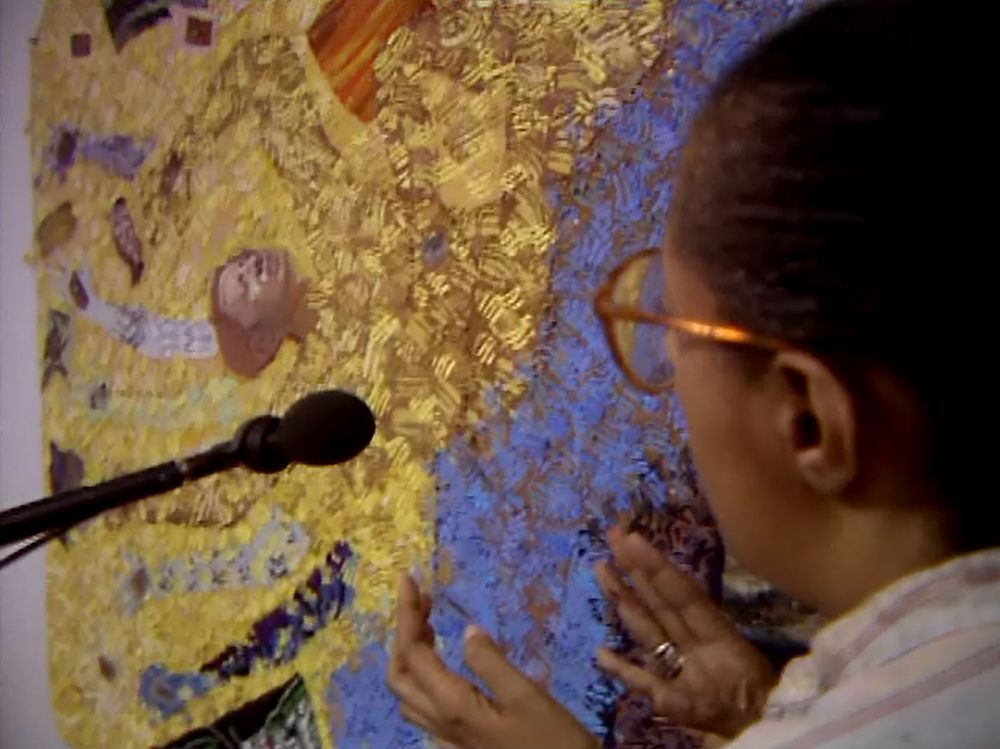Watching Howardena Pindell
/https://tf-cmsv2-smithsonianmag-media.s3.amazonaws.com/blogging/featured/HP_4007_SIV-top-image.jpg)
In 1980, painter, curator, and mixed-media artist Howardena Pindell debuted a short film entitled Free, White, and 21 at A.I.R. Gallery in New York. Her first work with moving images—and a stark diversion from her career as an established abstractionist—this film marked Pindell’s embrace of a new medium and the creation of what has been considered a seminal work in the history of American video art. Recounting her lived experiences as both a target and a neglected object of racism and misogyny, Free, White, and 21 features Pindell in the art of testimony. At once, she is a narrator, actor, and artist. As Pindell materializes in “whiteface,” playing the part of a newswoman interviewing Pindell the artist, and then, as Pindell the artist, wraps herself with medical bandages, viewers bear witness to the ways that oppression subsumes and swathes the identities of both the oppressed and their oppressors. Looking at once like a burn victim and a caricature of the “white liberals” of the art world and the women’s movement, Pindell here establishes herself through video performance as a deft storyteller. With Free, White, and 21, she embodies the role of a cultural critic, undergoing and performing a kind of social surgery.
In a catalog essay for the Museum of Contemporary Art Chicago’s exhibition Howardena Pindell: What Remains to Be Seen, curator Valeria Cassell Oliver explains the ways in which Pindell’s art and editorial work during this period established her public identity as an artist, citizen, and activist. Still, despite all the labels and identities that have been affixed to her, Pindell’s existence as a videographer and video subject remains largely under emphasized. Nonetheless, when we watch closely, Pindell’s handle on motion and effect is made apparent and profound across mediums.
Years before “Free, White, and 21,” Pindell was slowly and subtly introducing the language of movement and energy into her works. Most notably, her Video Drawings series from the 1970s, consisting of chromogenic prints that appear to conduct motion, orchestrates images using lines and arrows that flurry in a methodical mess of directives and directions. Overlaying images from national and global news, including scenes of hockey matches and presidential addresses, Pindell’s “drawings” adapted television into her art practice, freezing moving images in order to create new choreographies. In Atomizing Art, a 28-minute short film released by L&S Video Studios in 1999, Pindell is returned to the front of the camera once more as she reprises her role as an autobiographer and memoirist.

Created and produced by filmmaker Linda Freeman, whose papers include videotapes of interviews for the film, Atomizing Art sets out to introduce a “uncompromising artist with an insight into life spanning from the tiniest particle known to man: the atom, to the largest social issues of our time, including class, racism, and sexism.” Embracing the theme of atomization, the film follows Pindell as she converts her life and work into something legible for its presumed audience of schoolchildren. Resistant to the sugarcoating one might associate with children’s content, however, Pindell does not avoid mention of labor or trauma when telling her story. Instead, she settles at different points in the journey to share scenes from her childhood while also revealing the rigorous, painstaking, and eye-numbing work of creating her canvas pieces. In the midst of her molecular musings and anecdotes, Pindell offers a slew of advice. In her words, we ought to be wary of anything that is “totalitarian and says it’s not.”
As she responds to an invisible but audible interviewer, Pindell speaks throughout the film about the unique discrimination she’s faced as a Black woman, a phenomenon which law scholar Kimberlé Crenshaw famously articulated in 1989 with the theory of intersectionality, which sought to address workplace discrimination. “They were willing to hire a Black man but not a Black woman,” Pindell recalls when speaking about a job interview gone bad. Self-aware and sensitive, Pindell does not recount these setbacks and pains for mere entertainment or artistic value. Having suffered severe head trauma after a car accident in 1979, Pindell establishes early in the film the ways in which video work preforms the symbiotic function of restoring and relaying her memories. In this way, as a medium, these videos afford Pindell the space to “put beauty where [she] found ugliness”— whether that ugliness referred to racism, sexism, or the confusion wrought by memory loss.
For her painting Autobiography: The Search (Air/Chrysalis/Meditation, Positive/Negative) (1988–1989), the work featured on the DVD cover art for “Atomizing Art,” Pindell traced the shape of her own body to convey the beauty of introspection. In the work, Pindell appears retreating from the anatomical position, as if she has been overtaken by a spiritual and physical force. Transforming before a sea of colors and limbs, Pindell stars as a meditative figure in her own work. Still, yet ravaged by motion, the image demands the kind of engagement critical theorist Tina Campt called for when she described the act of “listening to images.” Pindell’s work across mediums asks us to consider what it would mean to watch and listen to images. Her work pushes us to imagine what it would look like to attend to and notice not only what an artwork is but also what it is doing.
This essay originally appeared on the Archives of American Art Blog.
